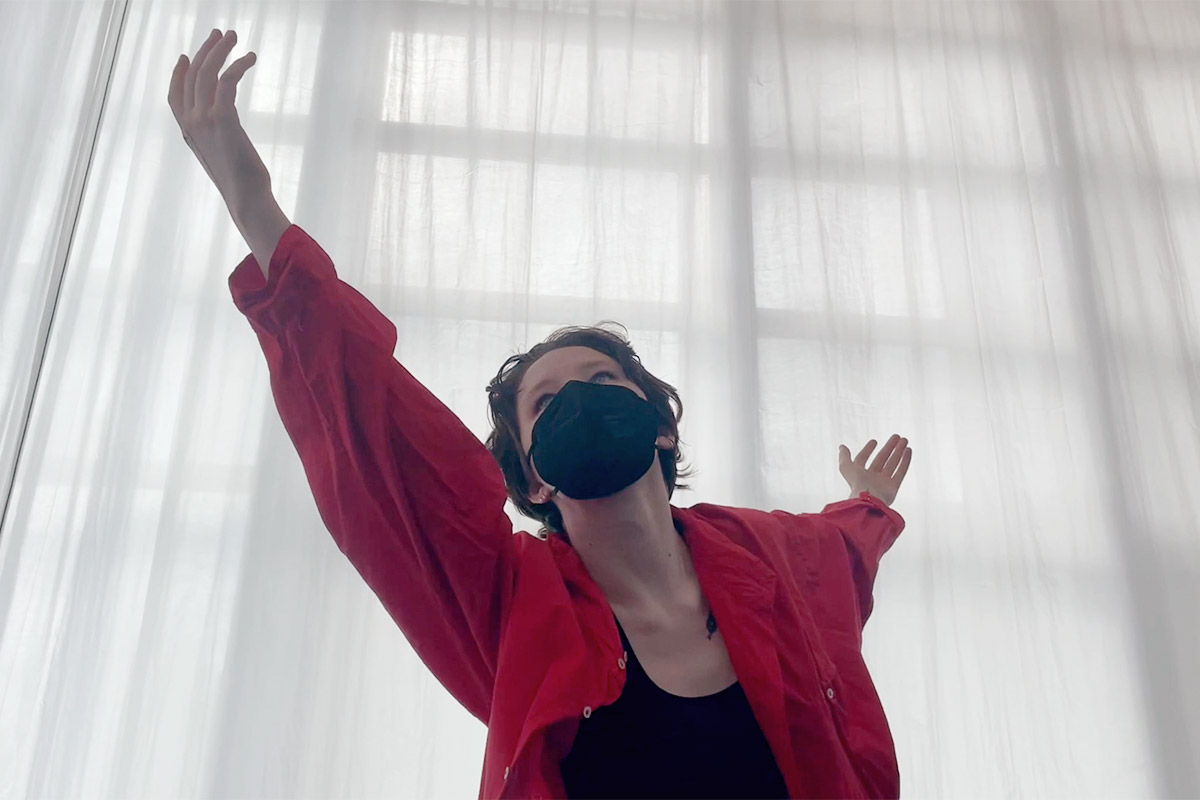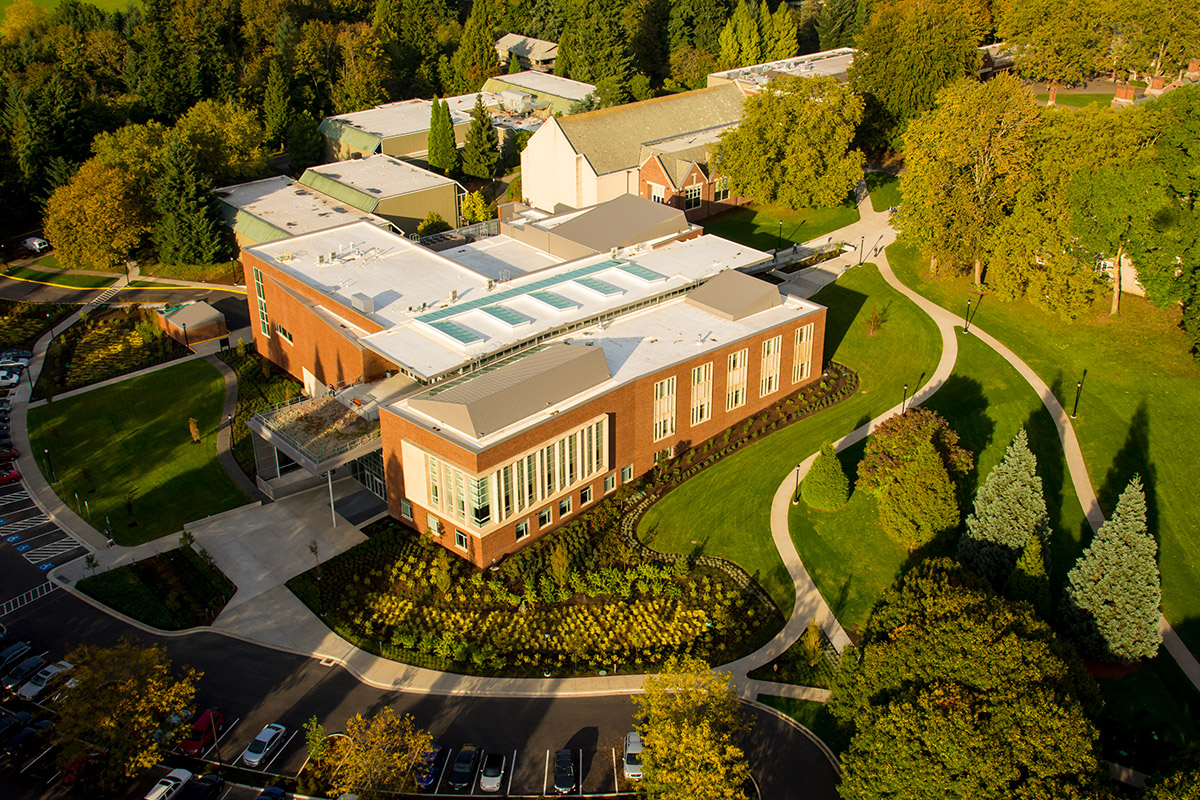Pirouetting Through the Pandemic
How Reed’s dance professors found creative ways to teach despite the challenges of social distancing.
The dancer begins in plié, her right arm extended upwards. From a distance, a steady crash of percussion punctuates her steps as she makes her way through space: a ronde de jambe transition into a leg extension, arms lifted, eyes skyward.
“Very nice,” Prof. Minh Tran cries out from behind his mask, voice echoing through the studio. “Let’s try it again from the top.”
When President Audrey Bilger announced that Reed would hold in-person classes last fall, she knew how students, staff, and faculty members were eager to return to campus. In order to make that happen, the college gave individual departments the power to design their own instructional models.
For the performing arts, where interaction between practitioners, instructors, and audiences is paramount, the pandemic posed an existential challenge. How do you re-envision the performing arts when circumstances prohibit physical collaboration? When, it’s fair to say, the very survival of your community depends on it?
All the faculty in the performing arts grappled with this question, none more so than the dance department. Dance is the only academic discipline at Reed which requires sustained athletic activity. “Teaching, practicing, making dance right now requires changing the way we do just about everything,” says Prof. Carla Mann ’81, the Judy Massee Professor of Dance.
After surveying students, she and her colleagues (Prof. Tran and Prof. Victoria Fortuna) learned that one of the things their students most longed for was proper space in which to dance.
“Yes they missed taking classes in person,” she says, “But even more limiting was trying to take those classes in their rooms, often in the tiny space between a bed and a chest of drawers.”
Over the summer, the professors hammered out a plan to use the Performing Arts Building (PAB), which had been closed since the spring due to the pandemic. If there was a safe way to dance inside that building, they were determined to find it.
“Our intention was that, should a student choose to take a dance class in one of Reed’s studios, they would be at no more risk than in one of Reed’s indoor conference classes,” says Prof. Mann. The issues were daunting. How many dancers could use the space at one time? How much time between classes was required for the ventilating system to disperse aerosols? What kind of masks were compatible with the aerobic nature of dance?
The department was fortunate to have a tremendous asset—the PAB, a modern building with spacious studios, high ceilings, and sophisticated ventilation. But was that enough? Enter Forensic Analytical Consulting Services, an environmental consulting firm with expertise in COVID-19. The firm ran an analysis on the risk potential based on the dimensions, materials, and ventilation specs of the facility. The experts came to the conclusion that—with a bit of creativity and a lot of dedication—the dance studios could safely re-open.
The plan called for limited numbers of students, increased ventilation, frequent cleaning, and masks. The dance faculty had to work within these constraints to maximize the usable floor space while minimizing risk of personal contact. It was here where Prof. Fortuna had an unorthodox idea.
Her solution was to create a grid system in the two dance studios that would help students and instructors to keep track of physical distance between them. They used masking tape to mark out 12-by-15-foot rectangles on the floor, creating a checkerboard pattern. Dancers were assigned alternate spaces on the grid so that no one was directly in front of or behind each other; there would be 14-foot “buffer zones” in between the spaces. “If each dancer is in the center of their area, they’re about 30 feet from anyone else,” Mann says. The next class to use each studio space would then alternate the squares in use once the studio had been sanitized.
It was a safe and cohesive system that would allow dancers to return to the PAB—but it raised several more questions. How would dancers in two separate studios see and hear the professor? And what about students who wanted to take classes remotely?
Luckily, the PAB was built with a state-of-the-art audio/visual system that allowed students virtual access to instruction if they couldn’t attend classes in person—something that would have been far more difficult in the department’s old home in the Sports Center.
As classes got underway, remote and in-person students were able to join the same Zoom class, which was projected on a large screen in each studio. This enabled the department to fit about a dozen students in each class, with more students participating remotely. “The Reed AV staff was heroic in making this system work,” says Mann.
Back in February, I dropped in on a Dance 411 class (Advanced Technique and Performance) and was impressed with how effective the hybrid strategy was. Prof. Tran taught choreography from his own studio, giving notes and cues in real time, while students danced in two separate studios and in remote locations. There was even a musical accompanist who joined via Zoom. The feel of the class was cohesive, collaborative, and focused.
Working online even had some upsides—the faculty was able to recruit dance artists and scholars from around the world to work with students. Interdisciplinary movement artist Eiko Otake joined one of Mann’s courses via Zoom from Japan for a week in November. Iconic American choreographer Ralph Lemon worked with Tran’s students for a week, Zooming in from New York.
The success of this model has become a point of pride for the entire Reed family. Thanks to technology, creativity, and heart, the dance department found a way to bring students together. After a year of isolation and anxiety, that’s an achievement we all can celebrate.
Tags: Academics, Campus Life, Covid-19, Giving Back to Reed, Institutional, Performing Arts

